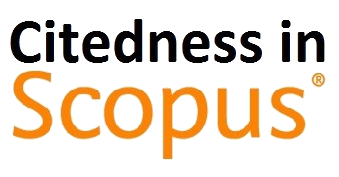Determination of The Closest Path Using The Greedy Algorithm
(1) Universitas Islam Negeri Sumatera Utara, Indonesia
(2) Universitas Islam Negeri Sumatera Utara, Indonesia
(3) Universitas Islam Negeri Sumatera Utara, Indonesia
(*) Corresponding Author
Abstract
Full Text:
PDFReferences
P. Di. Thanh, H. Thi Thanh Binh, D. Di. Dac, N. Binh Long, and L. M. Hai Phong, “A Heuristic Based on Randomized Greedy Algorithms for the Clustered Shortest-Path Tree Problem,” 2019 IEEE Congr. Evol. Comput. CEC 2019 - Proc., pp. 2915–2922, 2019, doi: 10.1109/CEC.2019.8790070.
M. M. lakshmi and M. M. S. priya, “Shortest Path Algorithm and its Implementation,” Int. J. Math. Trends Technol., vol. 36, no. 2, pp. 82–85, 2016, doi: 10.14445/22315373/ijmtt-v36p511.
Sabarudin, Raja, "Solusi Optimum Minmax 0/1 Knapsack Menggunakan Algoritma Greedy," Jurnal Evolusi , vol. 147, no.2 . March, pp. 11–40, 2016.
A. Juniar, A. Juniar Jurusan Sistem Informasi, and S. Tinggi Manajemen Industri -Kementerian Perindustrian Jl, “Penerapan Algoritma Greedy pada Penjadwalan Produksi Single-Stage dengan Parallel Machine di Industri Konveksi,” OKTOBER 2015 IJCCS, vol. 16, pp. 1–5.
S. Oktaviana and A. Naufal, “Algoritma Greedy untuk Optimalisasi Ruangan dalam Penyusunan Jadwal Perkuliahan,” 2017.
U. M. Rifanti and B. Arifwidodo, “The implementation of floyd algorithm in determining the shortest routes for tourism transportation,” Regist. J. Ilm. Teknol. Sist. Inf., vol. 5, no. 2, pp. 140–151, Jul. 2019, doi: 10.26594/register.v5i2.1683.
E. N. Hayati and A. Yohanes, “Pencarian Rute Terpendek Menggunakan Algoritma Greedy,” Semin. Nas. IENACO, pp. 2337–4349, 2014.
H. Azis, R. D. Mallongi, D. Lantara, and Y. Salim, “Comparison of Floyd-Warshall Algorithm and Greedy Algorithm in Determining the Shortest Route,” Proc. - 2nd East Indones. Conf. Comput. Inf. Technol. Internet Things Ind. EIConCIT 2018, pp. 294–298, 2018, doi: 10.1109/EIConCIT.2018.8878582.
S. Saifulloh and R. E. Fitriyani, “Analisa Pencarian Rute Tercepat Menuju Telaga Sarangan Menggunakan Algoritma Greedy,” J. Teknol. dan Ilmu Komput. Prima, vol. 1, no. 1, pp. 1–5, 2018, doi: 10.34012/jutikomp.v1i1.231.
Y. D. Mahendra, N. Nuryanto, and A. Burhanuddin, “Sistem Penentuan Jarak Terdekat Dalam Pengiriman Darah Di Pmi Kota Semarang Dengan Metode Algoritma Greedy,” J. Komtika, vol. 2, no. 2, pp. 136–142, 2019, doi: 10.31603/komtika.v2i2.2601.
DOI: https://doi.org/10.30645/ijistech.v7i5.332
Refbacks
- There are currently no refbacks.
Jumlah Kunjungan:
Published Papers Indexed/Abstracted By:












